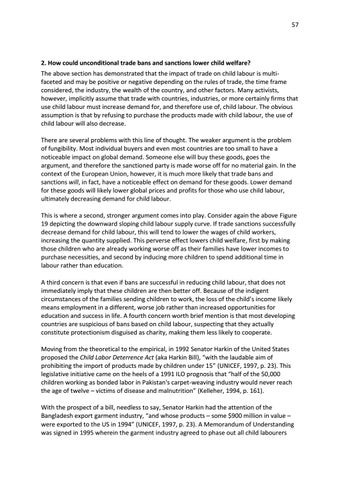57
2. How could unconditional trade bans and sanctions lower child welfare? The above section has demonstrated that the impact of trade on child labour is multifaceted and may be positive or negative depending on the rules of trade, the time frame considered, the industry, the wealth of the country, and other factors. Many activists, however, implicitly assume that trade with countries, industries, or more certainly firms that use child labour must increase demand for, and therefore use of, child labour. The obvious assumption is that by refusing to purchase the products made with child labour, the use of child labour will also decrease. There are several problems with this line of thought. The weaker argument is the problem of fungibility. Most individual buyers and even most countries are too small to have a noticeable impact on global demand. Someone else will buy these goods, goes the argument, and therefore the sanctioned party is made worse off for no material gain. In the context of the European Union, however, it is much more likely that trade bans and sanctions will, in fact, have a noticeable effect on demand for these goods. Lower demand for these goods will likely lower global prices and profits for those who use child labour, ultimately decreasing demand for child labour. This is where a second, stronger argument comes into play. Consider again the above Figure 19 depicting the downward sloping child labour supply curve. If trade sanctions successfully decrease demand for child labour, this will tend to lower the wages of child workers, increasing the quantity supplied. This perverse effect lowers child welfare, first by making those children who are already working worse off as their families have lower incomes to purchase necessities, and second by inducing more children to spend additional time in labour rather than education. A third concern is that even if bans are successful in reducing child labour, that does not immediately imply that these children are then better off. Because of the indigent circumstances of the families sending children to work, the loss of the child’s income likely means employment in a different, worse job rather than increased opportunities for education and success in life. A fourth concern worth brief mention is that most developing countries are suspicious of bans based on child labour, suspecting that they actually constitute protectionism disguised as charity, making them less likely to cooperate. Moving from the theoretical to the empirical, in 1992 Senator Harkin of the United States proposed the Child Labor Deterrence Act (aka Harkin Bill), “with the laudable aim of prohibiting the import of products made by children under 15” (UNICEF, 1997, p. 23). This legislative initiative came on the heels of a 1991 ILO prognosis that “half of the 50,000 children working as bonded labor in Pakistan's carpet-weaving industry would never reach the age of twelve – victims of disease and malnutrition” (Kelleher, 1994, p. 161). With the prospect of a bill, needless to say, Senator Harkin had the attention of the Bangladesh export garment industry, “and whose products – some $900 million in value – were exported to the US in 1994” (UNICEF, 1997, p. 23). A Memorandum of Understanding was signed in 1995 wherein the garment industry agreed to phase out all child labourers













